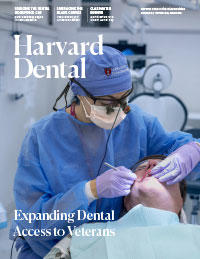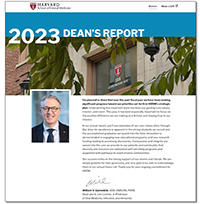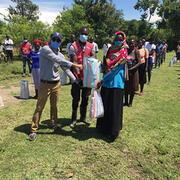
As Harvard School of Dental Medicine (HSDM) students and residents learned that the academic year would take an unprecedented turn due to the COVID-19 pandemic, several jumped into action, finding different ways to turn the challenges presented by the pandemic into opportunities to help. Whether through community outreach, research, or care, they quickly honed in on ways to aid their local and global communities.
Community Outreach in the Wake of COVID-19
When many K-12 schools nationwide had to abruptly transition online learning, students and families struggled to adapt to a new and unfamiliar learning style. Elizabeth Durham, DMD21, found an opportunity to provide support to these students through a program called CovEducation—an initiative started by collaborators from Harvard and MIT that promotes comprehensive access to web-based curricula and academic support for K-12 students, and eases the transition to virtual learning for students with limited access to resources.
“When the pandemic started, I really wanted to help others, but wasn’t sure what I could do from my home,” said Durham. “CovEducation connects mentors to students who need additional academic support due to their schools shutting down. Many have learning accommodations as well. This resonated with me because I understand how frustrating it can be to learn, especially if the teacher does not grasp what it is like to see material through that lens. It’s challenging, eye opening and I absolutely love it!”
As COVID-19 started to spread around the globe, Ashiana Jivraj, DMD21, jumped into action to provide support to the 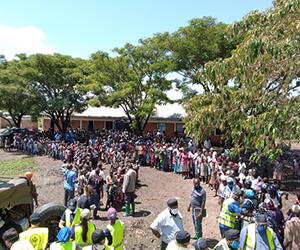 people of Kenya, a country where she has familial ties. In March, Jivraj and her cousin Dr. Hanif Gilani, launched a relief effort called Towa Kitu Kidogo to raise funds to help tackle the impact of COVID-19, as well as recent mass flooding that has devastated communities in Kenya. Both crises have exacerbated food insecurity in many communities. Their efforts have raised over $15,000 thus far, securing over $10,000 alone on food delivery and supplies.
people of Kenya, a country where she has familial ties. In March, Jivraj and her cousin Dr. Hanif Gilani, launched a relief effort called Towa Kitu Kidogo to raise funds to help tackle the impact of COVID-19, as well as recent mass flooding that has devastated communities in Kenya. Both crises have exacerbated food insecurity in many communities. Their efforts have raised over $15,000 thus far, securing over $10,000 alone on food delivery and supplies.
“The term ‘Towa Kitu Kidogo’ means ‘give something small,’ in Swahili, and is generally associated with corruption and bribery. We believe that giving something small, when in the right hands, can impact people on the ground level,” said Jivraj. “My family hails from Kenya, and I have seen first-hand the impact of socioeconomic inequality worsened during crises. Partnering with organizations and working as a community to solve challenges that come from income inequality has been the way I have seen change. The old African proverb says, ‘If you want to go fast, go alone; if you want to go far, go together.’ This is how I try to live my life.”
Action through Research and Education
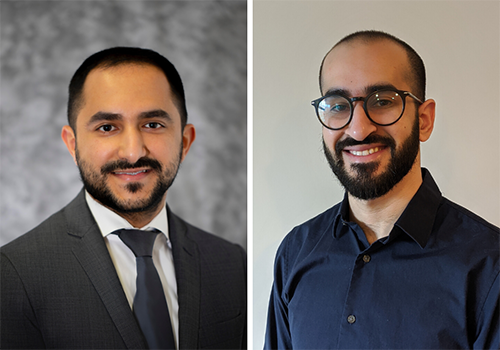 Dental public health residents Fahad Hegazi, DMSc22, and Hesham Alhazmi, DMSc21, saw an opportunity to impact the COVID-19 response through research. They partnered with colleagues from Boston Children’s Hospital, including Dr. Fatima Aldhaheri, an infectious disease fellow, and Dr. Kimberlee Gauvreau, a statistician, as well as providers at the Umberto I Polyclinic Hospital in Rome, Italy, to analyze COVID-19 data coming out of Italy. Dr. Paolo Fantozzi, who recently served as HSDM’s first Oral Oncology Fellow, connected Hegazi and Alhazmi with colleagues who were on the frontlines of the COVID-19 response in Italy. Their efforts resulted in a journal article titled, “Outcomes of COVID-19 Patients Presenting to an Emergency Department in Italy,” which is currently under review.
Dental public health residents Fahad Hegazi, DMSc22, and Hesham Alhazmi, DMSc21, saw an opportunity to impact the COVID-19 response through research. They partnered with colleagues from Boston Children’s Hospital, including Dr. Fatima Aldhaheri, an infectious disease fellow, and Dr. Kimberlee Gauvreau, a statistician, as well as providers at the Umberto I Polyclinic Hospital in Rome, Italy, to analyze COVID-19 data coming out of Italy. Dr. Paolo Fantozzi, who recently served as HSDM’s first Oral Oncology Fellow, connected Hegazi and Alhazmi with colleagues who were on the frontlines of the COVID-19 response in Italy. Their efforts resulted in a journal article titled, “Outcomes of COVID-19 Patients Presenting to an Emergency Department in Italy,” which is currently under review.
“Ever since the COVID-19 outbreak began, Hesham and I wanted to contribute to the COVID-19 literature. At the time, Italy was the epicenter of the outbreak with a very high case-fatality rate compared to the rest of the world. No one knew why, but they theorized it was due to the aging population in Italy, so we decided to get data from Italy itself,” Hegazi said. “As dental public health residents, it is our job to contribute to the literature that will benefit the health of the public. HSDM gave us the platform for this project to be successful.
Shortly after stay-at-home orders were given, and work places, universities, schools, and other businesses  mandated work-from-home and remote learning policies, Laura Pesquera, DMD23, joined students from Harvard Medical school and other universities around the country to develop the COVID-19 Health Literacy Project. The project grew into a free resource offered in more than 35 languages that was designed to help patients know when and how to seek care if they suspect they have contracted coronavirus. Pesquera provided the Spanish translations for the finished product.
mandated work-from-home and remote learning policies, Laura Pesquera, DMD23, joined students from Harvard Medical school and other universities around the country to develop the COVID-19 Health Literacy Project. The project grew into a free resource offered in more than 35 languages that was designed to help patients know when and how to seek care if they suspect they have contracted coronavirus. Pesquera provided the Spanish translations for the finished product.
Pesquera also worked with ContraCovid, which focuses on disseminating information about COVID-19 to marginalized communities and developing a social resources guide. The organization prioritizes helping Latino and immigrant families navigate the challenges of a global pandemic. Through her involvement with ContraCovid, Pesquera collaborated with students from Boston University, as well as local medical students in Puerto Rico.
“A lot of relevant COVID-19 information is not understandable or accessible to the lay public and this particular problem disproportionately affects communities like mine,” said Pesquera. “I feel great responsibility in helping the Latinx community and think it is important that we circulate correct information on the virus so that people can make appropriate decisions and reduce the spread of COVID-19. I’m deeply committed to reducing health disparities and believe language should never be a barrier to receiving quality care.”
Protecting Providers
Months before COVID-19 appeared in hospitals and health centers across the U.S., China faced unprecedented shortages in personal protective equipment (PPE) for healthcare providers. JC Lin, DMD21, a native of China, teamed up with classmates from high school to form a COVID-19 task force, fundraising and donating PPE to Chinese hospitals in need.
“Both of my parents are doctors in China, and I started following the situation of COVID-19 very early on,” said Lin. “In January, my dad was starting a new position in a hospital that only took in patients who were affected by coronavirus. I worried about them, as I heard there was a severe shortage of PPE among the nation, putting frontline healthcare workers at risk.” Lin and her former classmates began contacting hospitals to get accurate inventory of PPE, and making sure that any PPE that was purchased met the standards to be used in a hospital setting. She researched the PPE available in other regions and countries to see if they could be used in China. After locating acceptable PPE, Lin coordinated for PPE to be shipped to different Chinese hospitals from all over the world, including Australia, Pakistan, Canada, Brazil, and more. Their efforts resulted in over 30,000 N95 masks, 13,000 surgical masks, and 44,000 coveralls being delivered to more than 50 hospitals.
Lin and her former classmates began contacting hospitals to get accurate inventory of PPE, and making sure that any PPE that was purchased met the standards to be used in a hospital setting. She researched the PPE available in other regions and countries to see if they could be used in China. After locating acceptable PPE, Lin coordinated for PPE to be shipped to different Chinese hospitals from all over the world, including Australia, Pakistan, Canada, Brazil, and more. Their efforts resulted in over 30,000 N95 masks, 13,000 surgical masks, and 44,000 coveralls being delivered to more than 50 hospitals.
As the situation escalated in the U.S., Lin shifted gears and connected Chinese PPE suppliers with U.S. healthcare workers, donating supplies to senior housing facilities. “I started to hear about the difficult situation that many U.S. hospitals are facing with PPE, as well as senior housing. I am glad that I built some connections with the Chinese factories around January and February,” she said. “I quickly got into contact with some friends at U.S. hospitals and shared the factory contacts I had. At the same time, my friends and I heard many senior housing communities in California had a rapidly increasing number of confirmed cases. We quickly worked together and donated boxes of surgical masks to them.”
The fight against COVID-19 is far from over, but the newest generation of healthcare providers has shown that they are ready and willing to innovate and collaborate on creative solutions to the challenges that our world faces.

